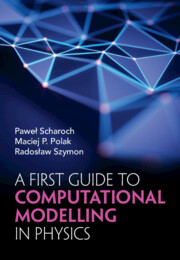Book contents
- Frontmatter
- Contents
- Preface
- How to Use the Book
- First Steps
- Project 1: Rectangular Finite Quantum Well – Stationary Schrödinger Equation in 1D
- Project 2: Diffraction of Light on a Slit
- Project 3: Pendulum as a Standard of the Unit of Time
- Project 4: Planetary System
- Project 5: Gravitation inside a Star
- Project 6: Normal Modes in a Cylindrical Waveguide
- Project 7: Thermal Insulation Properties of a Wall
- Project 8: Cylindrical Capacitor
- Advanced Projects
- Project 9: Coupled Harmonic Oscillators
- Project 10: The Fermi–Pasta–Ulam–Tsingou Problem
- Project 11: Hydrogen Star
- Project 12: Rectangular Quantum Well Filled with Electrons – The Idea of Self-Consistent Calculations
- Project 13: Time Dependent Schrödinger Equation
- Project 14: Poisson’s Equation in 2D
- Appendix A: Supplementary Materials
- Further Reading
- Index
Project 3: - Pendulum as a Standard of the Unit of Time
Published online by Cambridge University Press: 01 February 2024
- Frontmatter
- Contents
- Preface
- How to Use the Book
- First Steps
- Project 1: Rectangular Finite Quantum Well – Stationary Schrödinger Equation in 1D
- Project 2: Diffraction of Light on a Slit
- Project 3: Pendulum as a Standard of the Unit of Time
- Project 4: Planetary System
- Project 5: Gravitation inside a Star
- Project 6: Normal Modes in a Cylindrical Waveguide
- Project 7: Thermal Insulation Properties of a Wall
- Project 8: Cylindrical Capacitor
- Advanced Projects
- Project 9: Coupled Harmonic Oscillators
- Project 10: The Fermi–Pasta–Ulam–Tsingou Problem
- Project 11: Hydrogen Star
- Project 12: Rectangular Quantum Well Filled with Electrons – The Idea of Self-Consistent Calculations
- Project 13: Time Dependent Schrödinger Equation
- Project 14: Poisson’s Equation in 2D
- Appendix A: Supplementary Materials
- Further Reading
- Index
Summary
This project focuses on the Initial Value Problem (IVP) for ordinary differential equations with the application of multipoint recursion schemes. The effectiveness and convergence of these schemes are explored and subsequently applied to examine the properties of a compound pendulum, specifically the dependence of the oscillation period on energy. The chapter then focuses on Newton’s laws of motion, laying the foundation for understanding the motion equation. The project uses a simple pendulum to illustrate the concept, looking at how changes in amplitude affect the period of harmonic oscillations. Numerical methods, such as recursive methods based on local extrapolation, are then employed to derive formulas. The project concludes by discussing the integration of Runge–Kutta methods and implicit schemes to solve the equations. This project ultimately questions the viability of the pendulum as a standard unit of time, adding value to ongoing discussions in physics and mathematics education.
Keywords
Information
- Type
- Chapter
- Information
- A First Guide to Computational Modelling in Physics , pp. 18 - 25Publisher: Cambridge University PressPrint publication year: 2024
